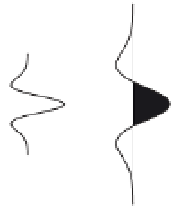Geoscience Reference
In-Depth Information
acoustic impedance contrasts within a
of the
stratigraphy, as also shown in
Section 6.7.4.1
. Whether a
recognisable re
ection is created depends on the magni-
tude of individual re
ection coef
cients, and also whether
their spacing results in suf
cient constructive interference
that an arrival is discernible against the background noise.
'
package
'
a)
Depth series (logs)
Acoustic
i
mpedanc
e
Reflection
c
oefficient
s
Velocity
Density
-
+
0
6.7.3
Interpretation pitfalls
Depth
The close resemblance between a seismic section and a
geological cross-section makes these data, in principle, one
of the geologically easiest to interpret. Nevertheless, the
interpreter should always have an appreciation for the reso-
lution of the data and be aware of the possibility of artefacts
in the data. Stacking and migration rely on simplifying
assumptions about the distribution of seismic properties in
the subsurface and, as such, may not work
Time series
b)
Reflectivity
series
Individual
reflections
Resulting
synthetic trace
-
+
-
+
'
perfectly
'
.
0
0
Refl #1
6.7.3.1
Artefacts
Ideally, data processing techniques, notably deconvolution,
will have removed multiples (see Multiples in
Section
attempt to identify periodic features in the data that may be
due to multiples. At any given location, the travel time of a
long-period multiple is an integer multiple of the travel
time of its equivalent primary. So if a strong reflection is
seen at, say, 0.5 s TWT at a given location, then the
interpreter should be suspicious of reflections that arrive
at 1.0 s, 1.5 s etc. In the presence of dip, the apparent dip of
the multiple increases relative to the primary and may cause
it to cross-cut primary re
Refl #2
Two-way
time
(TWT)
Refl #3
Refl #4
Source wavelet
c)
High-
frequency
synthetic
trace
Medium-
frequency
synthetic
trace
Low-
frequency
synthetic
trace
Reflectivity
series
ections with similar TWT. This
geologically unlikely situation (the response could theoret-
ically be from a sill) is one way to identify multiples.
Since multiples have to travel further than primaries
recorded at the same detector, they lose more energy
through attenuation (see
Section 6.3.3
)
and energy parti-
tioning (see Energy partitioning in
Section 6.3.4.2
)
. This
means they are of low amplitude unless associated with
re
ections from large contrasts in acoustic impedance. For
marine surveys the main source of multiples is the water
-
+
-
+
-
+
-
+
0
0
0
0
Two-way
time
(TWT)
Figure 6.44
Computation of a 1D synthetic seismic trace.
(a) Velocity and density logs and, the acoustic-impedance and
re
ectivity
series and the resultant synthetic seismic trace. The synthetic trace
comprises four occurrences of the source wavelet. (c) Synthetic
seismic traces computed using source wavelets of different
dominant wavelength/frequency.
ection-coef
cient logs calculated from them. (b) Re
Source wavelets






































































































Search WWH ::

Custom Search